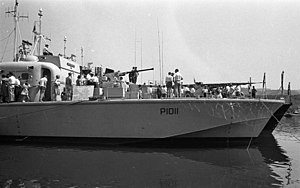Brave class fast patrol boat

HMS Brave Borderer on the Rhine, 1961
|
|
| Class overview | |
|---|---|
| Name: | Brave class |
| Builders: | Vosper & Company, Portchester |
| Operators: |
|
| Preceded by: | Dark class |
| Built: | 1958–1960 |
| In commission: | 1960–1970 |
| Completed: | 2 |
| Retired: | 2 |
| General characteristics | |
| Class and type: | Fast attack craft |
| Displacement: |
|
| Length: |
90 ft (27 m) wl 98 ft 10 in (30.12 m) overall |
| Beam: | 25 ft 6 in (7.77 m) |
| Draught: | 7 ft (2.1 m) |
| Propulsion: |
|
| Speed: |
52 knots (96 km/h; 60 mph) maximum 46 knots (85 km/h; 53 mph) continuous |
| Complement: | 20 (3 officers, 17 ratings) |
| Armament: |
|
90 ft (27 m) wl
52 knots (96 km/h; 60 mph) maximum
The Brave-class fast patrol boats were a class of two motor torpedo boats that were the last of their type for the Royal Navy (RN) Coastal Forces division. They formed the basis for a series of simpler boats, which were widely built for export.
The Brave class followed the Dark class of convertible motor torpedo boats/gunboats. They were larger than the Dark class, and differed in being powered by gas turbine engines rather than the diesel engines of the Dark class. (Gas turbine propulsion had been tested in the Bold class of two experimental fast patrol boats). Three Bristol Proteus engines propelled the Braves to a maximum of 52 knots (96 km/h; 60 mph). Like the Dark class, the Braves had a mahogany skin over aluminium frame construction. They were built to be able to be used as either motor torpedo boats or motor gun boats. For the former role they had a 40 mm Bofors gun, four torpedoes (21 inch diameter) and two depth charges, in the latter two 40 mm guns and two torpedoes. It was planned to arm the ships with a new 3.3 inches (84 mm) gun based on the 20 pounder tank gun in a stabilised mounting, but this was abandoned.
The Royal Navy abandoned the idea of large scale coastal forces in 1957, so only two Braves were built for the Royal Navy. The two Braves, along with a single member of the Dark class, formed the Coastal Forces Trials and Special Service Squadron, based as Gosport. These were used to maintain proficiency in Coastal Forces operations, also being used as targets and for fishery protection. The two Braves were retired from use in 1970.
The Braves were expensive boats, so as a private venture, Vospers produced a simpler derivative, Ferocity. This was smaller than the Braves, with an overall length of 90 feet 8 inches (27.64 m) and was powered by two Proteus engines instead of three, which were supplemented by two diesel engines for cruising. Construction was all wooden to minimise costs. Despite the reduced size and power, performance and armament were similar to the Braves. While Ferocity herself was not sold, it formed the basis for a number of boats for export. These included sales to West Germany (two, called the Vosper class), Denmark (five of the Søløven class), Greece, Malaysia for the RMN in 1966 (four craft), Brunei and Libya, and was also the basis for the Scimitar-class fast training boat.
...
Wikipedia
